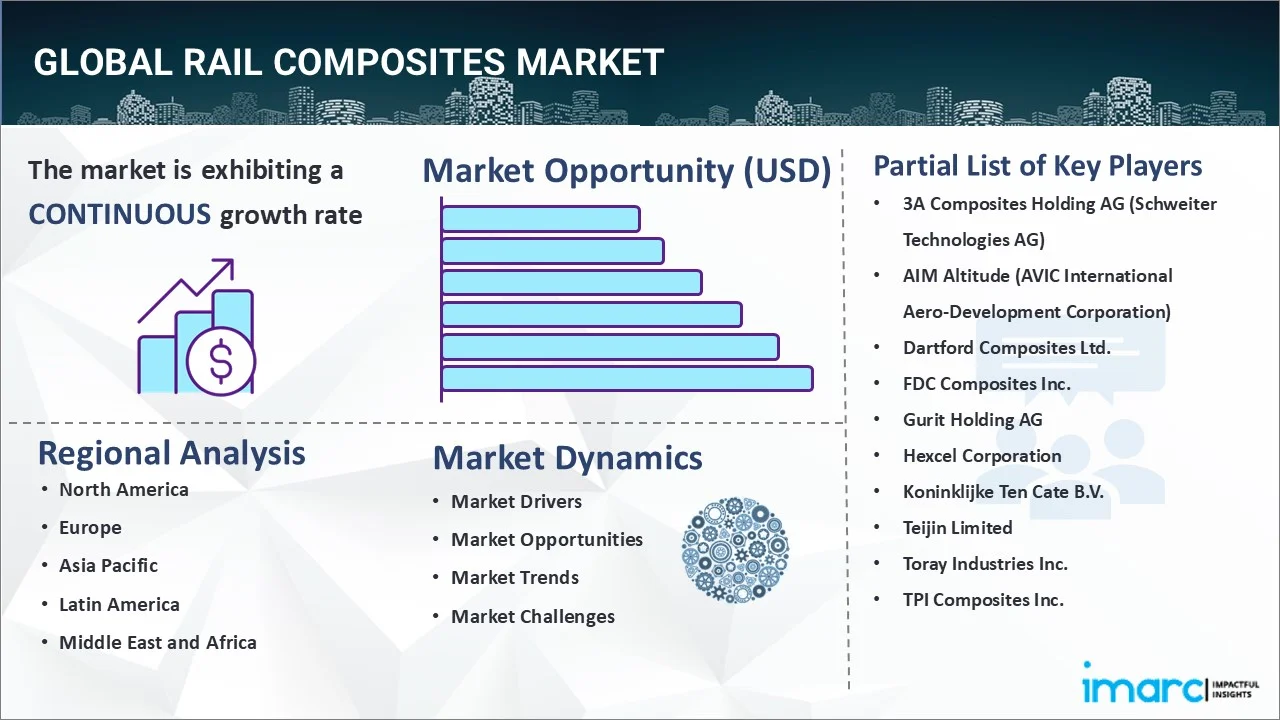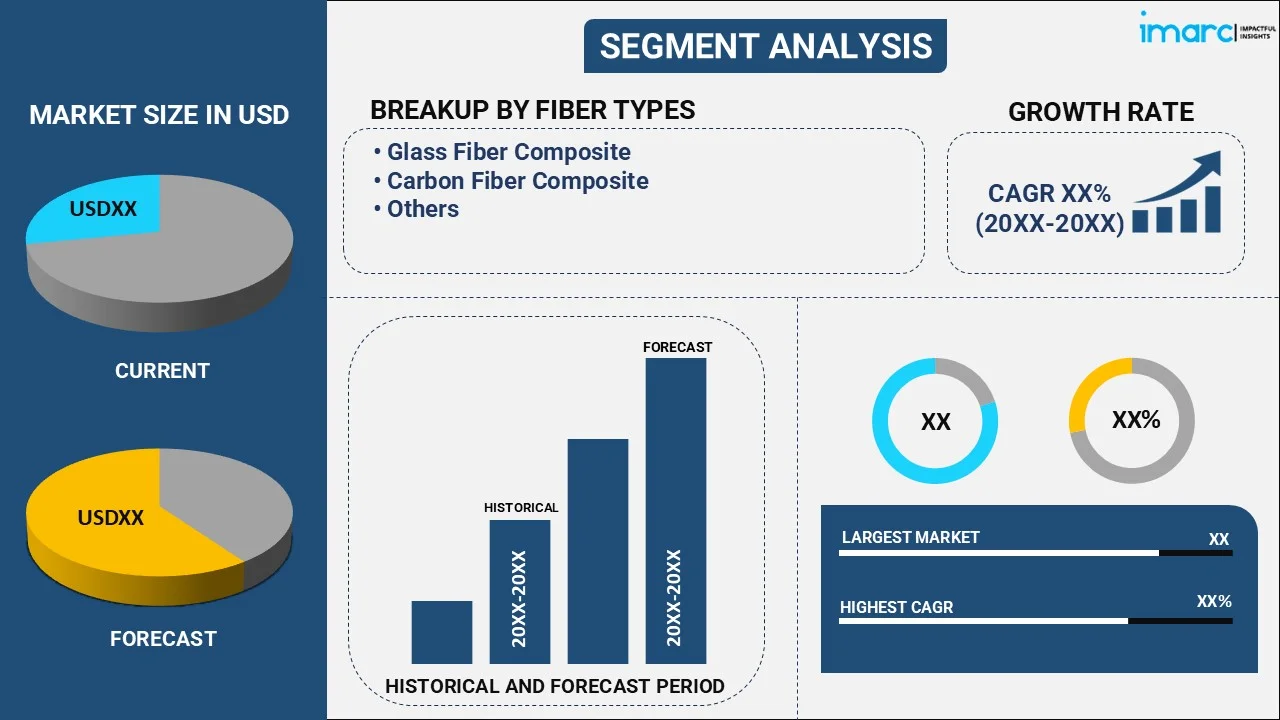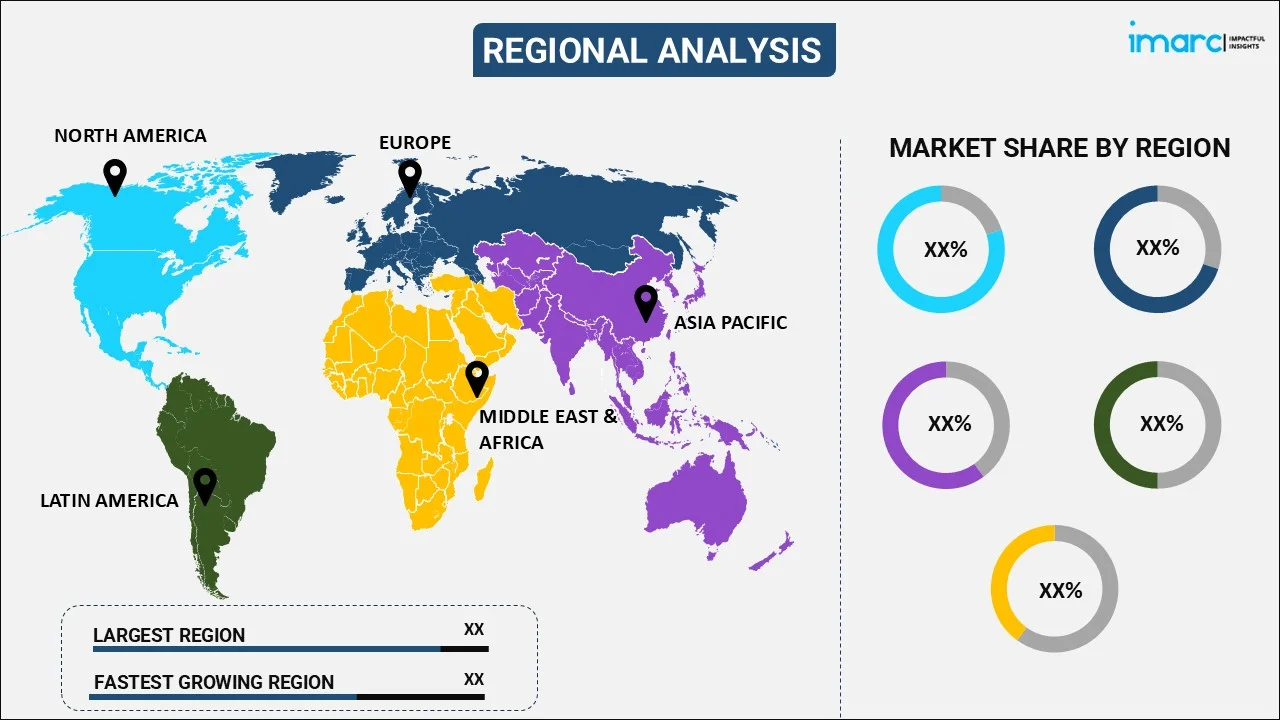
Rail Composites Market Report by Fiber Type (Glass Fiber Composite, Carbon Fiber Composite, and Others), Resin Type (Polyester, Vinyl Ester, Phenolic, Epoxy, and Others), Application (Interior, Exterior), and Region 2025-2033
Market Overview:
The global rail composites market size reached USD 1.8 Million in 2024. Looking forward, IMARC Group expects the market to reach USD 3.3 Million by 2033, exhibiting a growth rate (CAGR) of 6.4% during 2025-2033. Growing demand for lightweight and fuel-efficient materials, the rising trend of high-speed rail networks, and a surging focus on passenger safety represent some of the key factors driving the market.
|
Report Attribute
|
Key Statistics
|
|---|---|
|
Base Year
|
2024
|
|
Forecast Years
|
2025-2033
|
|
Historical Years
|
2019-2024
|
| Market Size in 2024 | USD 1.8 Million |
| Market Forecast in 2033 | USD 3.3 Million |
| Market Growth Rate 2025-2033 | 6.4% |
Rail composites are composite materials used to produce railway components such as train body structures, doors, seats, and floors. They are also used in manufacturing electrical insulation components and signal poles. Rail composites are made by combining two or more materials, such as resin with glass or carbon fiber, to produce a material with superior characteristics. One of its major advantages is its weight reduction capabilities, further minimizing fuel consumption and operating costs. Rail composites also have higher strength-to-weight ratios, making them stronger and more durable than traditional materials. Compared to traditional materials, rail composites have a longer lifespan and require less maintenance. They are also resistant to corrosion, fire, and chemicals. Currently, there are various types of product variants available, including glass-reinforced, carbon-fiber-reinforced, and aramid-reinforced composites.

Rail Composites Market Trends:
The global rail composites market is primarily driven by the growing demand for lightweight and fuel-efficient materials in the rail industry. Additionally, the rising trend of high-speed rail networks, surging focus on passenger safety, and the increasing need to reduce maintenance costs are boosting the market growth. Moreover, the growing awareness regarding the advantages of rail composites, such as durability, high strength, and excellent fire resistance properties, along with the surging adoption of green technology, are fueling the market growth. Furthermore, the escalating demand for urban transportation and the need for effective public transport systems are providing an impetus to the market growth. Other factors, such as the growing demand for fuel-efficient transportation, the rising focus on reducing carbon emissions, and the escalating need for high-performance materials and innovative solutions, are favoring the market growth.
Key Market Segmentation:
IMARC Group provides an analysis of the key trends in each sub-segment of the global rail composites market report, along with forecasts at the global, regional and country level from 2025-2033. Our report has categorized the market based on fiber type, resin type and application.
Fiber Type Insights:

- Glass Fiber Composite
- Carbon Fiber Composite
- Others
The report has provided a detailed breakup and analysis of the rail composites market based on the fiber type. This includes glass fiber composite, carbon fiber composite, and others. According to the report, glass fiber composite accounted for the largest market share.
Resin Type Insights:
- Polyester
- Vinyl Ester
- Phenolic
- Epoxy
- Others
The report has provided a detailed breakup and analysis of the rail composites market based on the resin type. This includes polyester, vinyl ester, phenolic, epoxy, and others. According to the report, polyester accounted for the largest market share.
Application Insights:
- Interior
- Exterior
The report has provided a detailed breakup and analysis of the rail composites market based on the application. This includes interior and exterior. According to the report, exterior accounted for the largest market share.
Regional Insights:

- North America
- United States
- Canada
- Asia Pacific
- China
- Japan
- India
- South Korea
- Australia
- Indonesia
- Others
- Europe
- Germany
- France
- United Kingdom
- Italy
- Spain
- Russia
- Others
- Latin America
- Brazil
- Mexico
- Others
- Middle East and Africa
The report has also provided a comprehensive analysis of all the major regional markets, which include North America (the United States and Canada); Europe (Germany, France, the United Kingdom, Italy, Spain, Russia, and others); Asia Pacific (China, Japan, India, South Korea, Australia, Indonesia, and others); Latin America (Brazil, Mexico, and others); and the Middle East and Africa. According to the report, Asia Pacific was the largest market for rail composites. Some of the factors driving the Asia Pacific rail composites market included the surging demand for light-weight rail materials with high strength and durability, the expanding railway network, the growing preference for sustainable and eco-friendly materials, and the increasing focus on safety and performance.
Competitive Landscape:
The report has also provided a comprehensive analysis of the competitive landscape in the global rail composites market. Competitive analysis such as market structure, market share by key players, player positioning, top winning strategies, competitive dashboard, and company evaluation quadrant has been covered in the report. Also, detailed profiles of all major companies have been provided. Some of the companies covered include 3A Composites Holding AG (Schweiter Technologies AG), AIM Altitude (AVIC International Aero-Development Corporation), Dartford Composites Ltd., FDC Composites Inc., Gurit Holding AG, Hexcel Corporation, Koninklijke Ten Cate B.V., Teijin Limited, Toray Industries Inc., and TPI Composites Inc. Kindly note that this only represents a partial list of companies, and the complete list has been provided in the report.
Report Coverage:
| Report Features | Details |
|---|---|
| Base Year of the Analysis | 2024 |
| Historical Period | 2019-2024 |
| Forecast Period | 2025-2033 |
| Units | Million USD |
| Segment Coverage | Fiber Type, Resin Type, Application, Region |
| Region Covered | Asia Pacific, Europe, North America, Latin America, Middle East and Africa |
| Countries Covered | United States, Canada, Germany, France, United Kingdom, Italy, Spain, Russia, China, Japan, India, South Korea, Australia, Indonesia, Brazil, Mexico |
| Companies Covered | 3A Composites Holding AG (Schweiter Technologies AG), AIM Altitude (AVIC International Aero-Development Corporation), Dartford Composites Ltd., FDC Composites Inc., Gurit Holding AG, Hexcel Corporation, Koninklijke Ten Cate B.V., Teijin Limited, Toray Industries Inc. and TPI Composites Inc. |
| Customization Scope | 10% Free Customization |
| Post-Sale Analyst Support | 10-12 Weeks |
| Delivery Format | PDF and Excel through Email (We can also provide the editable version of the report in PPT/Word format on special request) |
Key Questions Answered in This Report:
- How has the global rail composites market performed so far, and how will it perform in the coming years?
- What are the drivers, restraints, and opportunities in the global rail composites market?
- What is the impact of each driver, restraint, and opportunity on the global rail composites market?
- What are the key regional markets?
- Which countries represent the most attractive rail composites market?
- What is the breakup of the market based on fiber type?
- Which is the most attractive fiber type in the rail composites market?
- What is the breakup of the market based on the resin type?
- Which is the most attractive resin type in the rail composites market?
- What is the breakup of the market based on application?
- Which is the most attractive application in the rail composites market?
- What is the competitive structure of the global rail composites market?
- Who are the key players/companies in the global rail composites market?
Key Benefits for Stakeholders:
- IMARC’s report offers a comprehensive quantitative analysis of various market segments, historical and current market trends, market forecasts, and dynamics of the rail composites market from 2019-2033.
- The research study provides the latest information on the market drivers, challenges, and opportunities in the global rail composites market.
- The study maps the leading, as well as the fastest-growing, regional markets. It further enables stakeholders to identify the key country-level markets within each region.
- Porter's five forces analysis assist stakeholders in assessing the impact of new entrants, competitive rivalry, supplier power, buyer power, and the threat of substitution. It helps stakeholders to analyze the level of competition within the rail composites industry and its attractiveness.
- Competitive landscape allows stakeholders to understand their competitive environment and provides an insight into the current positions of key players in the market.
Need more help?
- Speak to our experienced analysts for insights on the current market scenarios.
- Include additional segments and countries to customize the report as per your requirement.
- Gain an unparalleled competitive advantage in your domain by understanding how to utilize the report and positively impacting your operations and revenue.
- For further assistance, please connect with our analysts.
 Request Customization
Request Customization
 Speak to an Analyst
Speak to an Analyst
 Request Brochure
Request Brochure
 Inquire Before Buying
Inquire Before Buying




.webp)




.webp)












